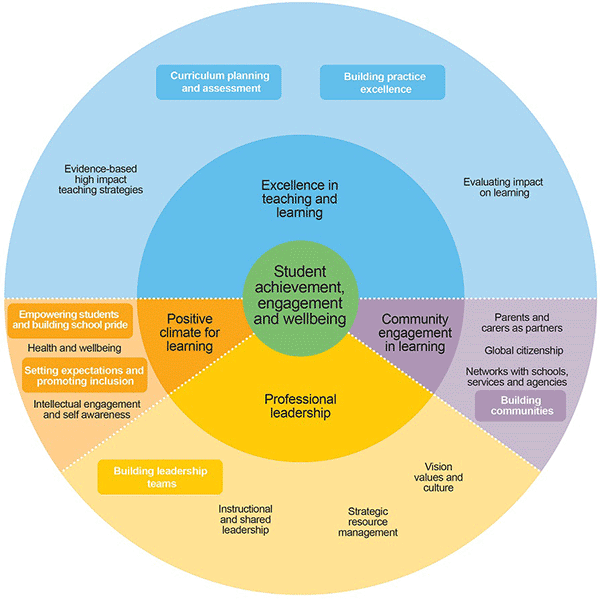This dimension is part of the
Community Engagement in Learning priority.
Navigate the FISO Improvement Model

Overview
Schools develop and foster partnerships with other schools, their CoP, community-based organisations, service agencies, government and non-government organisations to create networks that promote and support student achievement, wellbeing and engagement.
Effective partnerships develop common understandings and evidence-based practices, challenging potential barriers to learning and engagement. They support health and wellbeing, promote positive social relationships, allow for service referrals, and support students to achieve more and raise their aspirations.
Improving measures
Existing system data on networks with schools, services and agencies is limited.
The 'school stage transitions' factor in the Attitudes to School Survey, and the 'positive transitions' factor in the Parent Opinion Survey, may help schools gauge the strength of their networks.
A useful resource for specialist schools is the Parent Opinion Survey 'satisfaction with services around special needs' factor.
Supporting resources
Communities of Practice
Partnerships and Collaboration with Other Schools
Continuum
The Continuum for
Networks with schools, services and agencies describes a range of proficiency levels (Emerging, Evolving, Embedding and Excelling) that assists principals and teachers to identify areas of practice that require attention in order to deliver improved student outcomes.
Component: The school establishes partnerships
Emerging
Leaders and teachers work with specialist services, education providers and community organisations to support the learning, health and wellbeing needs of individual students. Leaders consider using school facilities for the delivery of services. Leaders commit resources to establish and maintain partnerships and networks.
Evolving
Leaders and teachers establish partnership links, connections and referral pathways to services, agencies, and community learning organisations that support students with specific learning, engagement, health and wellbeing needs.
Embedding
Leaders and teachers participate in networked learning communities in which students’ specific needs are addressed through the sharing of facilities, expertise and knowledge. Partnership members forge agreements and create structures that promote the sharing of facilities, expertise and professional knowledge. Leaders collaborate with partners and networks to strengthen expectations and close gaps in achievement for specific student groups.
Excelling
Leaders establish the school as a hub, with community services on-site, and provide access and referral pathways to community support services. Partnership members collaborate to plan, strategically engaging in joint actions and collectively monitoring progress at regular intervals. Leaders, teachers and partnership members actively seek to grow and diversify their partnerships/ networks for the benefit of the school community.
Case studies
To see examples of how schools in Victoria are implementing the FISO dimension: Networks with schools, services and agencies see: Networks with schools, services and agencies case studies.
Evidence base
To view the Evidence Base for the FISO community engagement in learning priority area see:
 Evidence- Community engagement in learning evidence base.
Evidence- Community engagement in learning evidence base.
FAQs
Why should my school engage with this dimension?
Research has found that when schools establish strong partnerships and links with parents/carers, other schools, business, industry, and community organisations, student health, wellbeing and learning outcomes are enhanced.
These network partners share responsibility for, and commit to providing the support, expertise and resources required to address specific needs of students.
To what extent is this dimension being implemented in my school?
Consider whether your school has developed links and partnerships with members of the immediate and broader community to address the specific health, wellbeing and learning needs of its students.
What can my school focus on?
- Strengthening school partnerships with parents/carers.
- Establishing links with community organisations to provide support and resources to help students improve their confidence, health and learning.
- Establishing network partnerships with other schools to share resources and expertise.
What does successful implementation look like?
- Schools collaborate with parents/carers, community organisations and other schools to improve students' engagement and learning.
- Schools establish links with community services that promote health and wellbeing of students and staff.
- Schools utilise resources, expertise and support from community members to meet the specific identified health, wellbeing and/or learning needs of individual students to close gaps in achievement, particularly in cohorts of identified students.
- Data is collected and shared among partners to evaluate the impact of these interventions on improved student learning and behaviour.
What strategies and actions can my school implement?
- Establish an inclusive and welcoming school culture which embodies the school vision and values, in order to strengthen parent/carer partnerships.
- Identify individual and particular cohort student health and wellbeing needs.
- Seek out community organisations and NGOs able to provide health, wellbeing and learning support and expertise.
- Establish links with network schools to share resources and expertise.
More information
For more information, see:
Community Engagement in Learning Learning priority